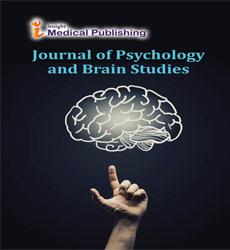Factors Triggering Development of Autism
Robert Coin*
Department of Psychology, University of Southern Queensland, Springfield Central, Australia
- *Corresponding Author:
- Robert Coin
Department of Psychology
University of Southern Queensland, Springfield Central, Australia
E-mail: coinrob23@yahoo.com
Received Date: October 07, 2021; Accepted Date: October 21, 2021; Published Date: October 28, 2021
Citation: Coin R (2021) Factors Triggering the Development of Autism. J Psychol Brain Stud Vol. 5, No.10:46.
Autism is a neurodevelopmental condition marked by communication and social behaviour difficulties, as well as repetitive behaviours. Although genetic factors may be largely responsible for the occurrence of autism, they cannot fully account for all cases, and it is likely that specific environmental factors, in addition to a specific combination of autism-related genes, may act as risk factors triggering the development of autism. Multiple genes have been implicated in autism over the last decade, accounting for around 15% of cases including autism spectrum disorders. In this setting, an increasing proportion of ASDs can be linked to rare genetic abnormalities that are either inherited or appear de novo, and new mutations and candidate genes are being uncovered on a regular basis. Aside from a few single particular genes that have been linked to autism, current research supports the idea of polygenic inheritance, which means that numerous genes are likely to be involved in predisposing an individual to develop autism. As a result, in addition to genetic inheritance, common variables such as shared prenatal environment may play a role in the development of ASD.
Furthermore, the rising prevalence of autism has focused attention on the potential role of chemicals in our environment. Extending the notion of pure genetic causation, it appears likely that, in addition to a certain mix of autism-related genes, exposure to specific environmental stimuli may be required in some individuals to initiate the development of autism. Autism is a developmental disease, and the majority of cases are diagnosed before the age of three, sometimes as early as 14 months. Nonetheless, autism may be present from birth rather than developing during this developmental period. Failures in early foetal brain development have been related to an increased risk of autism, and kids exposed to viral or bacterial infections in pregnancy have received special attention. Prenatal influenza, rubella, and CMV infections, for example, have all been linked to autism.
The risk of autism from prenatal infections is most likely determined by the mother's and foetus’s specific immunological condition. This is supported by the discovery of a possible link between autism and autoimmune illness and allergies, especially in mothers. As a result, because the placenta acts as a source of hematopoietic stem cells for the foetus, maternal illness could affect the immunological status of the foetal brain and the foetal immune system in general. Metal ion homeostasis is required for optimal brain function, and disruption is linked to severe neurological symptoms and cognitive illnesses. Zinc (Zn2+) insufficiency has a wide range of consequences on the brain. Zn2+ is the second most prevalent trace element in the body and, as a result, plays a part in a variety of processes, including cell division and differentiation. Hundreds of enzymes, for example, require Zn2+ to function. Copper (Cu2+) and zinc (Zn2+) play opposing roles in the body, with Cu2+ overload leading to Zn2+ shortage. Furthermore, additional research indicates that the Cu2+/Zn2+ ratio in the serum of autistic people is elevated.
Neuropsychological symptoms, learning and memory difficulties, behavioural issues, and an increase in glutamate excitotoxicity are all caused by Zn2+ deficiency. As a result, Zn2+ deficiency is linked to the incidence of seizures, and many autistic patients suffer from epilepsy. Thus, Zn2+ may operate as a gene/environment interaction mechanism, and maternal Zn2+ insufficiency may act as a risk factor for autism. Zn2+ deficiency affects newborn behaviour in pregnant rhesus monkeys. Intriguingly, Zn2+ deficiency is known to impair the immune system, suggesting a relationship to prenatal illnesses. In addition to maternal health, environmental chemicals endanger the development of a foetus, resulting in birth abnormalities. Teratogens have been proposed as a possible risk factor for autism.
The incidence of autism, for example, is significantly higher in children treated prenatally to the anticonvulsant agent valproic acid or the immunomodulatory agent thalidomide early in the first trimester of pregnancy. Valproic acid, for example, is a histone deacetylase inhibitor and may change the methylation pattern of autism-associated genes, so influencing their expression. Taken together, the evidence suggests that autism is a genetic condition. Twin studies suggest that autism has a genetic foundation, and genome-wide association studies have revealed some intriguing candidate genes. Nonetheless, environmental influences can have a significant impact on the development of autism. It is tempting to hypothesise that most of the risk factors reported thus far, such as prenatal stress, prenatal infection, maternal Zn2+ shortage, and maternal exposure to toxins, as well as potential novel factors that will be identified in the future, are all different sides of the same coin.
Open Access Journals
- Aquaculture & Veterinary Science
- Chemistry & Chemical Sciences
- Clinical Sciences
- Engineering
- General Science
- Genetics & Molecular Biology
- Health Care & Nursing
- Immunology & Microbiology
- Materials Science
- Mathematics & Physics
- Medical Sciences
- Neurology & Psychiatry
- Oncology & Cancer Science
- Pharmaceutical Sciences
